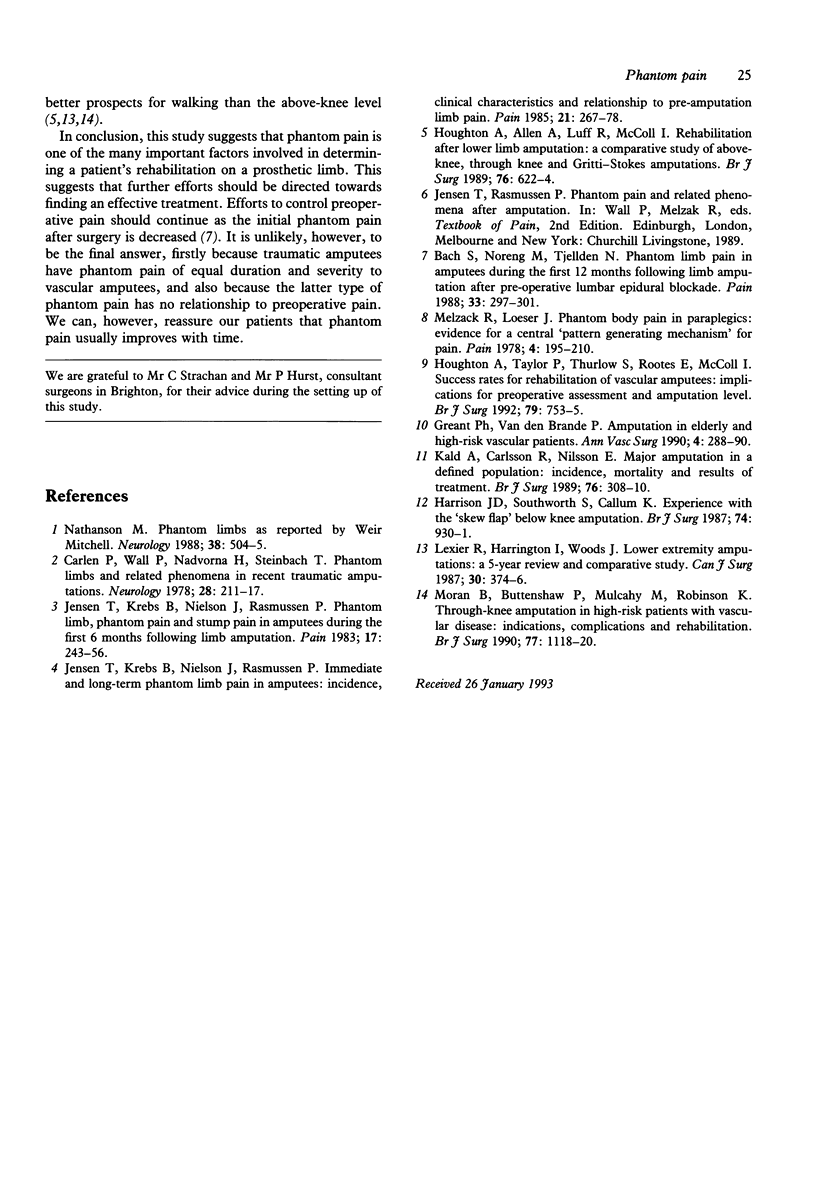Abstract
All 338 lower limb amputees under the care of one disablement services centre were asked to assess phantom pain severity at different times after amputation. Of 212 (63%) replies, 13 had died, 22 were non-limb wearers and 22 were unable to complete the questionnaire. In all, 176 useful replies were received--96 below-knee, 74 above-knee and 6 through-knee. Of these, 98 amputations were performed for trauma and 78 for vascular disease. Below-knee amputees rehabilitated better than above-knee amputees (P < 0.05) and traumatic better than vascular amputees (P < 0.0001). Preoperative pain was worse in vascular amputees (P < 0.0005), but there was no significant difference in the amount of phantom-pain experienced by vascular and traumatic amputees. Phantom sensations were experienced by 82% and phantom pain by 78%. Phantom pain decreased with time, was present equally in traumatic and vascular amputees, and was related to the amount of preoperative pain (P < 0.005). Only 22% felt phantom pain had impaired their rehabilitation. Rehabilitation score was related to phantom pain severity at the time of questionnaire completion (P < 0.05), but not at other specified times after operation.
Full text
PDF



Selected References
These references are in PubMed. This may not be the complete list of references from this article.
- Bach S., Noreng M. F., Tjéllden N. U. Phantom limb pain in amputees during the first 12 months following limb amputation, after preoperative lumbar epidural blockade. Pain. 1988 Jun;33(3):297–301. doi: 10.1016/0304-3959(88)90288-6. [DOI] [PubMed] [Google Scholar]
- Carlen P. L., Wall P. D., Nadvorna H., Steinbach T. Phantom limbs and related phenomena in recent traumatic amputations. Neurology. 1978 Mar;28(3):211–217. doi: 10.1212/wnl.28.3.211. [DOI] [PubMed] [Google Scholar]
- Greant P., Van den Brande P. Amputation in elderly and high-risk vascular patients. Ann Vasc Surg. 1990 May;4(3):288–290. doi: 10.1007/BF02009459. [DOI] [PubMed] [Google Scholar]
- Harrison J. D., Southworth S., Callum K. G. Experience with the 'skew flap' below-knee amputation. Br J Surg. 1987 Oct;74(10):930–931. doi: 10.1002/bjs.1800741017. [DOI] [PubMed] [Google Scholar]
- Houghton A. D., Taylor P. R., Thurlow S., Rootes E., McColl I. Success rates for rehabilitation of vascular amputees: implications for preoperative assessment and amputation level. Br J Surg. 1992 Aug;79(8):753–755. doi: 10.1002/bjs.1800790811. [DOI] [PubMed] [Google Scholar]
- Houghton A., Allen A., Luff R., McColl I. Rehabilitation after lower limb amputation: a comparative study of above-knee, through-knee and Gritti-Stokes amputations. Br J Surg. 1989 Jun;76(6):622–624. doi: 10.1002/bjs.1800760633. [DOI] [PubMed] [Google Scholar]
- Jensen T. S., Krebs B., Nielsen J., Rasmussen P. Immediate and long-term phantom limb pain in amputees: incidence, clinical characteristics and relationship to pre-amputation limb pain. Pain. 1985 Mar;21(3):267–278. doi: 10.1016/0304-3959(85)90090-9. [DOI] [PubMed] [Google Scholar]
- Jensen T. S., Krebs B., Nielsen J., Rasmussen P. Phantom limb, phantom pain and stump pain in amputees during the first 6 months following limb amputation. Pain. 1983 Nov;17(3):243–256. doi: 10.1016/0304-3959(83)90097-0. [DOI] [PubMed] [Google Scholar]
- Kald A., Carlsson R., Nilsson E. Major amputation in a defined population: incidence, mortality and results of treatment. Br J Surg. 1989 Mar;76(3):308–310. doi: 10.1002/bjs.1800760328. [DOI] [PubMed] [Google Scholar]
- Lexier R. R., Harrington I. J., Woods J. M. Lower extremity amputations: a 5-year review and comparative study. Can J Surg. 1987 Sep;30(5):374–376. [PubMed] [Google Scholar]
- Melzack R., Loeser J. D. Phantom body pain in paraplegics: evidence for a central "pattern generating mechanism" for pain. Pain. 1978 Feb;4(3):195–210. doi: 10.1016/0304-3959(77)90133-6. [DOI] [PubMed] [Google Scholar]
- Moran B. J., Buttenshaw P., Mulcahy M., Robinson K. P. Through-knee amputation in high-risk patients with vascular disease: indications, complications and rehabilitation. Br J Surg. 1990 Oct;77(10):1118–1120. doi: 10.1002/bjs.1800771014. [DOI] [PubMed] [Google Scholar]
- Nathanson M. Phantom limbs as reported by S. Weir Mitchell. Neurology. 1988 Mar;38(3):504–505. doi: 10.1212/wnl.38.3.504. [DOI] [PubMed] [Google Scholar]


